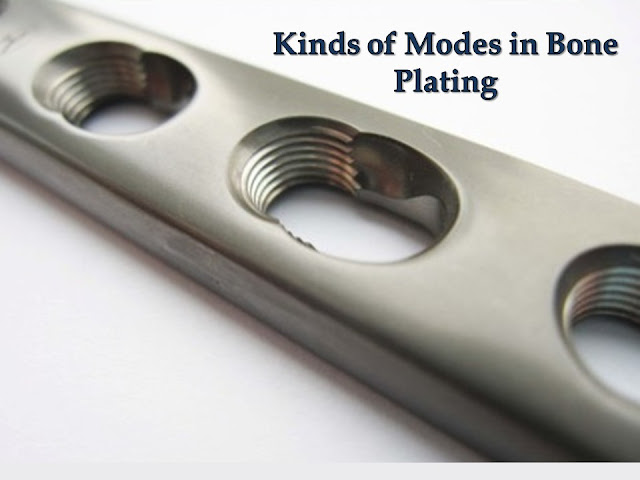A bone plate may be placed so that it may be utilized as one of the following kinds of structural support:
· Compression Mode
· Neutralization Mode
· Buttress plate
· Antiglide plate
· Bridge plating or span plating
· Tension band
Plates are available in various shapes and sizes depending on the bone size and its anatomical shape. Various plat sizes need different screw sizes.
Depending upon the fracture type and location, a plate can be used in any one of the following methods.
Compression Mode:
The word compression in fixation of fracture means bringing the two fragments closer to one another so that the fragments oppose well.
When plate is utilized to achieve compression with the fracture fixation, it is said to be utilized in compression mode. This mode is utilized on oblique and transverse fractures
Neutralization Mode:
In this king of plating, a lag screw is utilized to neutralize shear, bending and rotational forces. The goal of this kind of plating is not to attain compression (this has already been attained by the lag screw).
This type of plating is also utilized as an adjunct where bone screws are used alone in long bones a correct reconstruction with interfragmentary compression can be attained, but screws are not mainly strong in resisting twisting or bending forces. Addition of a bone plate offers further resistance to such forces.
The fibular fracture normally seen in ankle injuries is usually fixed with lag screws protected by a neutralization plate.
Buttress Plate:
A buttress is an architectural structure built against or projecting from a wall which helps to reinforce or support the wall.
A buttress plate is utilized to prevent collapse in fracture patterns which are unstable under forces that are compressive.
A buttress plate is very thin in comparison of compression plate and is usually applied on compressive surface of the bone.
This is the most usual method that plates are used around joints.
Here there is a comparatively soft cancellous bone core enclosed by a thin layer of together cortical bone. Correct osteosynthesis may be attained by lag screws alone but under load there may be a risk of screws cutting out of the bone or bending.
The addition of a bone plate will prevent such deformity under axial load. The plate should be located where the maximum load is predicted to be. Proximal tibia, for example, plates may be needed on one side or another to protect a fixation of tibial plateau fracture.
There are especially shaped plates for the most common anatomical buttressing needs, and these make plate application easier.
Antiglide Plate:
In antiglide plating, the plate is fixed to the bone in such a manner that it prevents the distal fragment from overriding when force is applied along the long bone axis.
The distal fragment is firmly impacted between the plate and the fracture surface of the proximal plane.
This principle is generally applied in distal fibula fracture. It can be known as a variation of compression plating.
Siora Surgical well known and establish trauma implants manufacturers in India. The company manufactures different rage of product such as Small Fragment Locking Implants, Hip Prosthesis, Interlocking Nails, Bone Screws, Locking Plates, Trauma Bone Plates, AFN Nailing System, Cannulated Screws, Large Fragment Locking Compression Plate, Mini Fragment Implants.



